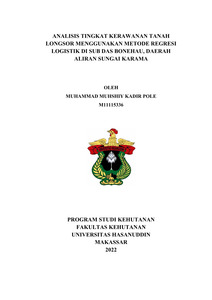Pole, Muhammad Muhshiy Kadir (2022) Analisis Tingkat Kerawanan Tanah Longsor Menggunakan Metode Regresi Logistik di Sub DAS Bonehau, Daerah Aliran Sungai Karama = The application of GIS-Statistic Based Logistic Regression for Landslide Susceptibility Analysis in Bonehau Sub Watershed, West Sulawesi. Skripsi thesis, Universitas Hasanuddin.
![[thumbnail of Cover]](/16431/1.hassmallThumbnailVersion/M11115336_skripsi_27-04-2022%20cover1.png)

M11115336_skripsi_27-04-2022 cover1.png
Download (203kB) | Preview
M11115336_skripsi_27-04-2022 1-2.pdf
Download (747kB)
M11115336_skripsi_27-04-2022 dp.pdf
Download (4MB)
M11115336_skripsi_27-04-2022.pdf
Restricted to Repository staff only
Download (7MB)
Abstract (Abstrak)
Landslides have taken a significant role in the evolution of landscapes, are present almost everywhere, and serve as one of the catastrophic subjects of frequent natural disasters. The statistical-spatial modeling based on ethics of care in this era has become an advanced tool for assessing landslide hazards. The Bonehau sub-watershed shows a hydrogeomorphology that is identic to the occurrence of landslides. Moreover, 2.47% forested land converted annually supports the initiation and reactivation of landslide events. 2,468 landslide events detected in Google Earth imagery served as the basis for assessing vulnerability, hazard, and risk of landslides. The causative factor discrimination in frequency ratio (FR) shows that lithological factors, LCC, and slopes are the primary causes of landslides. The LSM was then constructed using a logistic regression model (LR). The ROC curve in the model is more inclined towards the sensitivity axis with AUC success and predictive of 0.732 and 0.674, respectively.
Keywords : landslide susceptibility map, landslide inventory, frequency ratio, logistic regression, ROC Curve, Bonehau Sub Watershed
| Item Type: | Thesis (Skripsi) |
|---|---|
| Subjects: | S Agriculture > SD Forestry |
| Divisions (Program Studi): | Fakultas Kehutanan > Kehutanan |
| Depositing User: | S.Sos Rasman - |
| Date Deposited: | 08 Jun 2022 03:26 |
| Last Modified: | 08 Jun 2022 03:26 |
| URI: | http://repository.unhas.ac.id:443/id/eprint/16431 |


